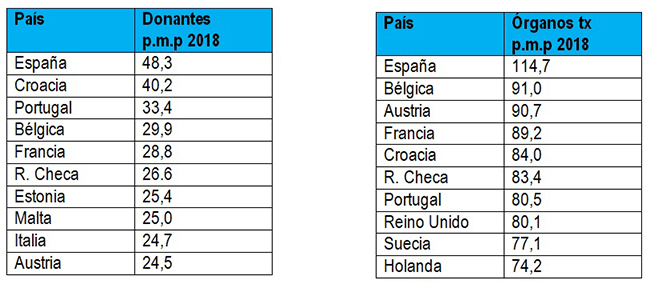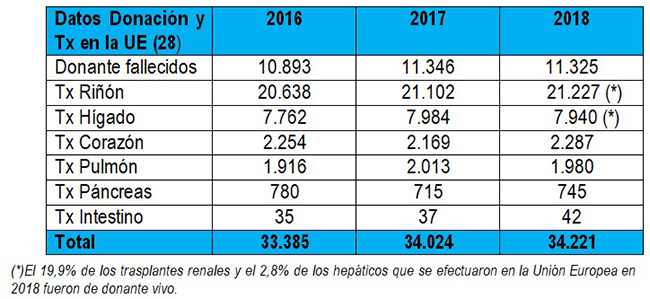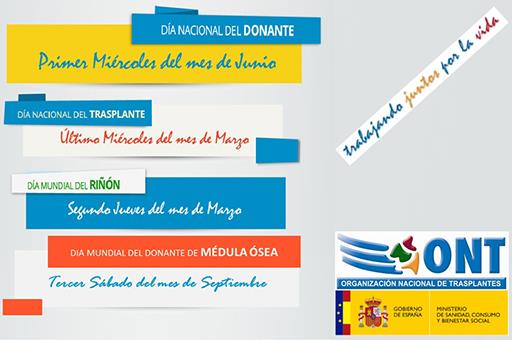The Spanish National Transplant Organisation has been managing this registry on behalf of the WHO for 12 years and publishing its data in the 'Newsletter Transplant'
World Transplant Registry reports 139,024 transplants performed worldwide last year, up 2.3%
News - 2019.8.28
Transplants continue on the rise around the world, although more slowly than necessary. At least, that is what can be extracted from the latest figures published by the World Transplant Registry, managed by the National Transplant Organisation (Spanish acronym: ONT) for the last 13 years, in collaboration with the World Health Organization (WHO), which quoted the total number of organ transplants in the world last year at 139,024. This figure is up 2.3% on the previous year (135,960).
Of that total, 90,306 were kidney transplants (36.5% live-donor), 32,348 were liver transplants (19% live-donor), 7,881 were heart transplants, 6,084 were lung transplants, 2,243 were pancreas transplants and 162 were intestinal transplants. These figures covered barely 10% of the transplant needs in the world, quoted by the WHO at more than 1 million a year. These transplants were made possible thanks to 37,447 deceased donors, up 9.8% on just over 34,000 the previous year. These were joined by close to 46,000 live kidney and liver donors. 60% of all live donors are women.
These figures are contained in the official publication of the Council of Europe's Committee on Organ Transplantation ('Newsletter Transplant' 2018), which will shortly be made available on the ONT web page. Published by the ONT, 'Newsletter Transplant' is the main source of official information in the world reflecting a large part of the data contained in the World Registry. This year's edition includes data from 82 countries, including India.
Since the Council of Europe started this publication, its content has considerably improved, gradually extending both in terms of the number of countries covered, and the data offered on each of them. In recent years, countries such as Saudi Arabia, Kuwait, Malaysia, Qatar, Sudan and Syria have begun collaborating with the World Transplant Registry. For its part, the ONT team tasked with managing the Register has refined the data it requests, extending and consolidating the prestige of the 'Newsletter Transplant'.
Spain's leadership
Spain has renewed its clear leadership, for the 27th year running, with a rate of donors per million population (p.m.p.) of 48.3. The World Transplant Registry works with the figures contained in the United Nations Fund. This explains the slight difference between the rate recorded by the ONT at the end of 2018 (48 p.m.p.) slightly lower than that allocated by the World Transplant Registry, which had it marginally higher at 48.3 donors p.m.p.
The World Registry figures also show Spain's significant participation in the donation of organs around the world: our country exported 19.8% of all organ donations in the European Union last year, and 6% of all those recorded around the world, despite Spain only representing 9.1% of the European population and 0.6% of the world's population.
The undoubted leadership of our country in this field is also patently clear when analysing organ transplant p.m.p. indexes, in which Spain has maintained its global leadership now for many years. Spain posted a figure of 114.7 transplants p.m.p. last year, slightly higher than the United States (114.4 p.m.p.), and significantly higher than the European average (67.1 p.m.p.). The United States has a higher contribution from live donation in transplant activity. Organs transplanted from deceased donors stand at 107.9 p.m.p. in Spain and 93.5 p.m.p. in the United States.
European Union
The significant level of transplant activity in our country last year has further accentuated the distance between Spain and other EU countries, where both organ donation and transplants have remained virtually stable.
34,221 transplants were performed in the EU last year (compared with 34,024 the previous year), with 11,325 organ donations and a rate of 22.2 deceased donors per million population.
The following EU countries posted the highest organ donor rates:
 Ministerio de Sanidad, Consumo y Bienestar Social
Ministerio de Sanidad, Consumo y Bienestar Social
Those EU countries that have implemented the Spanish transplant model in whole or in part, such as Croatia, France, Italy and Portugal, continue to head up the ranking in terms of organ donor and transplant rates. The same is true of those other countries that have introduced measures to improve the role played by ER professionals and ICU staff in the identification of possible donors, following the recommendations made by our country, such as the United Kingdom, which has considerably improved its donation and transplant rate in recent years.
Figures in the EU by organ
 Ministerio de Sanidad, Consumo y Bienestar Social
Ministerio de Sanidad, Consumo y Bienestar Social
As regards the waiting list, data from the World Registry put the number of European patients waiting for a transplant at 31 December at 59,845, 5% up on the previous year.
According to the same data, 10 patients died every day last year in the European Union while waiting for a transplant, the same figure as in the previous year.
Organ donor rates in other countries
The Council of Europe publication also includes data from Australia, Canada, the United States and Russia, as well as Latin American countries. The organ donor rate in the United States has risen to 32.8 donors p.m.p., with a total of 10,722 deceased donors. This increase has been boosted by the epidemic of deaths caused by parenteral drug use in the country.
Australia, which has received consultancy in this regard from Spain, has also posted improvements in its organ donor rates over recent years, with a figure of 22.3 donors p.m.p. in 2018, while this figure stands at 20.6 donors p.m.p. in Canada and 4.5 donors p.m.p. in Russia, a slight rise.
Latin America, with which Spain has been working in this field for over 15 years now via the Ibero-American Network/Council on Organ Donation and Transplantation (Spanish acronym: RCIDT) on both management consultancy and training for transplant coordination professionals, also posted an organ donor rate increase of 3.6% to 9.2 donors p.m.p., accounting for a total of 17,381 organ transplants. Since Spain began to cooperate in this regard in the region, total organ donation growth now exceeds 85%. This is the largest growth figure worldwide for a region as a whole.
Donation rises in Spain in 2019
International transplant figures once again ratify Spain's leadership in this field, which last year reached a rate of 48.3 organ donors p.m.p. Last year, a total of 2,241 organ donors were recorded in Spain, enabling 5.321 organ transplants to be performed. In total, 3,313 kidney transplants, 1,230 liver transplants, 321 heart transplants, 369 lung transplants, 82 pancreas transplants and six intestinal transplants were performed.
Asystolic donation and collaboration from ER professionals and ICU staff and transplant coordinators in the identification of potential donors have become key factors in the increasing number of donors in Spain.
In turn, Spain has extensive experience in organ donation from elderly donors with positive results, which is an area for potential improvement in other countries. A good example is the recent study made by the nephrology service at Hospital del Mar (Barcelona), which shows improved kidney transplant results from elderly donors than those staying on dialysis, both in terms of survival and in the quality of life of the patient. In our country, half of all donors are aged over 60, significantly higher than in other peer countries.
The upward trend posted in Spain in the field of organ donation and transplantation in recent years has continued into the first half of 2019. Data from the Spanish National Transplant Organisation on the first six months of 2019 reflect a 3.6% increase in the number of donors.
The ONT would like to stress that Spanish citizens needing a transplant are far more likely to receive one than anywhere else in the world. This is possible thanks to the work of the healthcare professionals and the solidarity of our citizens.
Non official translation





